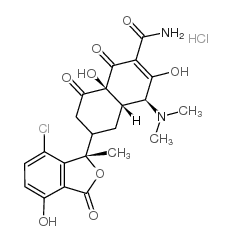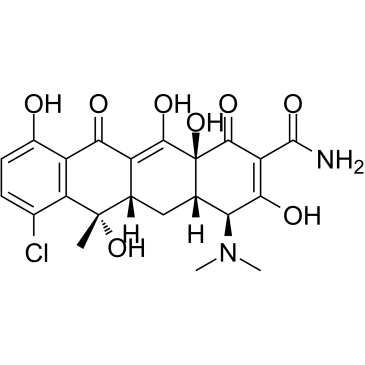514-53-4
| 中文名 | 金霉素 |
|---|---|
| 英文名 | (4S,4aS,6S,8aR)-6-[(1S)-7-chloro-4-hydroxy-1-methyl-3-oxo-2-benzofuran-1-yl]-4-(dimethylamino)-1,8a-dihydroxy-3,8-dioxo-4a,5,6,7-tetrahydro-4H-naphthalene-2-carboxamide |
| 英文别名 |
isochlortetracycline
7-chloro-2,3-indolinedione 7-monochloroisatin 7-chloroindoline-2,3-dione 7-chloro-2,3-dihydro-1H-indole-2,3-dione 7-Chlor-isotetracyclin 7-chloro-1H-benzo[d]azolidine-2,3-dione 7-chloro-isotetracycline 7-chloroisatine 7-chloro isatin |
| 描述 | Isochlortetracycline 是金霉素 (Chlortetracycline (HY-B1327A)) (广谱抗生素) 的无活性碱性降解产物。 |
|---|---|
| 相关类别 | |
| 参考文献 |
| 密度 | 1.61g/cm3 |
|---|---|
| 沸点 | 743.1ºC at 760mmHg |
| 熔点 | 231-236ºC (dec.) |
| 分子式 | C22H24Cl2N2O8 |
| 分子量 | 515.34100 |
| 闪点 | 403.2ºC |
| 精确质量 | 514.09100 |
| PSA | 167.46000 |
| LogP | 2.07020 |
| 储存条件 | Amber Vial, -20°C Freezer, Under Inert Atmosphere |
Synonym:ISOCTC; 2-Naphthalenecarboxamide, 6-(7-chloro-1,3-dihydro-4-hydroxy-1-methyl-3-oxo-1-benzofuranyl)-4 Section 2 - COMPOSITION, INFORMATION ON INGREDIENTS
Risk Phrases: None Listed. Section 3 - HAZARDS IDENTIFICATION EMERGENCY OVERVIEW
Moisture sensitive.Light sensitive.The toxicological properties of this material have not been fully investigated. Potential Health Effects Eye: May cause eye irritation. Skin: May cause skin irritation. Ingestion: May cause irritation of the digestive tract. The toxicological properties of this substance have not been fully investigated. Inhalation: May cause respiratory tract irritation. The toxicological properties of this substance have not been fully investigated. Chronic: No information found. Section 4 - FIRST AID MEASURES Eyes: Flush eyes with plenty of water for at least 15 minutes, occasionally lifting the upper and lower eyelids. Get medical aid. Skin: Get medical aid. Flush skin with plenty of water for at least 15 minutes while removing contaminated clothing and shoes. Wash clothing before reuse. Ingestion: Never give anything by mouth to an unconscious person. Get medical aid. Do NOT induce vomiting. If conscious and alert, rinse mouth and drink 2-4 cupfuls of milk or water. Inhalation: Remove from exposure and move to fresh air immediately. If not breathing, give artificial respiration. If breathing is difficult, give oxygen. Get medical aid. Notes to Physician: Section 5 - FIRE FIGHTING MEASURES General Information: As in any fire, wear a self-contained breathing apparatus in pressure-demand, MSHA/NIOSH (approved or equivalent), and full protective gear. During a fire, irritating and highly toxic gases may be generated by thermal decomposition or combustion. Extinguishing Media: Do NOT get water inside containers. Use water spray, dry chemical, carbon dioxide, or appropriate foam. Section 6 - ACCIDENTAL RELEASE MEASURES General Information: Use proper personal protective equipment as indicated in Section 8. Spills/Leaks: Sweep up, then place into a suitable container for disposal. Provide ventilation. Do not get water inside containers. Section 7 - HANDLING and STORAGE Handling: Wash thoroughly after handling. Remove contaminated clothing and wash before reuse. Use with adequate ventilation. Avoid contact with eyes, skin, and clothing. Avoid ingestion and inhalation. Store protected from light. Do not allow contact with water. Keep from contact with moist air and steam. Storage: Store in a tightly closed container. Store in a cool, dry, well-ventilated area away from incompatible substances. Store protected from moisture. Store protected from light. Section 8 - EXPOSURE CONTROLS, PERSONAL PROTECTION Engineering Controls: Facilities storing or utilizing this material should be equipped with an eyewash facility and a safety shower. Use adequate ventilation to keep airborne concentrations low. Exposure Limits CAS# 514-53-4: Personal Protective Equipment Eyes: Wear safety glasses and chemical goggles if splashing is possible. Wear appropriate protective eyeglasses or chemical safety goggles as described by OSHA's eye and face protection regulations in 29 CFR 1910.133 or European Standard EN166. Skin: Wear appropriate protective gloves to prevent skin exposure. Clothing: Wear appropriate protective clothing to prevent skin exposure. Respirators: A respiratory protection program that meets OSHA's 29 CFR 1910.134 and ANSI Z88.2 requirements or European Standard EN 149 must be followed whenever workplace conditions warrant respirator use. Section 9 - PHYSICAL AND CHEMICAL PROPERTIES Physical State: Solid Color: light beige Odor: None reported. pH: Not available. Vapor Pressure: Not available. Viscosity: Not available. Boiling Point: Not available. Freezing/Melting Point: 234 deg C Autoignition Temperature: Not applicable. Flash Point: Not applicable. Explosion Limits, lower: Not available. Explosion Limits, upper: Not available. Decomposition Temperature: Not available. Solubility in water: 1:2000 m/v Specific Gravity/Density: Not available. Molecular Formula: C22H23ClN2O8.HCl Molecular Weight: 515.34 Section 10 - STABILITY AND REACTIVITY Chemical Stability: Stable under normal temperatures and pressures. Moisture sensitive. Light sensitive. Conditions to Avoid: Incompatible materials, light, moisture, strong oxidants. Incompatibilities with Other Materials: Moisture, direct light, oxidizing agents. Hazardous Decomposition Products: Hydrogen chloride, nitrogen oxides, carbon monoxide, irritating and toxic fumes and gases, carbon dioxide, nitrogen. Hazardous Polymerization: Has not been reported. Section 11 - TOXICOLOGICAL INFORMATION RTECS#: CAS# 514-53-4: QJ1891700 LD50/LC50: CAS# 514-53-4: Oral, mouse: LD50 = >10 gm/kg. Carcinogenicity: Isochlortetracycline hydrochloride - Not listed by ACGIH, IARC, or NTP. Other: See actual entry in RTECS for complete information. Section 12 - ECOLOGICAL INFORMATION Section 13 - DISPOSAL CONSIDERATIONS Dispose of in a manner consistent with federal, state, and local regulations. Section 14 - TRANSPORT INFORMATION IATA Not regulated as a hazardous material. IMO Not regulated as a hazardous material. RID/ADR Not regulated as a hazardous material. Section 15 - REGULATORY INFORMATION European/International Regulations European Labeling in Accordance with EC Directives Hazard Symbols: Not available. Risk Phrases: Safety Phrases: S 24/25 Avoid contact with skin and eyes. WGK (Water Danger/Protection) CAS# 514-53-4: No information available. Canada None of the chemicals in this product are listed on the DSL/NDSL list. CAS# 514-53-4 is not listed on Canada's Ingredient Disclosure List. US FEDERAL TSCA CAS# 514-53-4 is not listed on the TSCA inventory. It is for research and development use only. SECTION 16 - ADDITIONAL INFORMATION N/A |
|
~% 
514-53-4 |
| 文献:McCormick et al. Journal of the American Chemical Society, 1957 , vol. 79, p. 2849,2856 |
| 上游产品 1 | |
|---|---|
| 下游产品 0 | |


